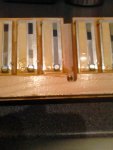I appear to have a split in the wood of one of the reed blocks in the base section of my accordion. I'm not sure if the split goes all the way through to the inside, but assuming it does what is the best way to repair it? Wood glue, silicone, patch over it???
You are using an out of date browser. It may not display this or other websites correctly.
You should upgrade or use an alternative browser.
You should upgrade or use an alternative browser.
Split in reed block
- Thread starter knobby
- Start date
- Status
- Not open for further replies.
Thanks Jim. I'd better get some ordered.
Glenn said:What made you open the accordion to investigate Knobby?
I have a couple of problems with the base end. The main problem is slow starting of some reeds, i.e. if I hold down a button and open the bellows slowly I dont get any sound. Open the bellows a bit faster and one reed will start; a bit faster and another one will kick in, and so on. I thought it may be the reed valves but theyre all fine (see my post regarding Birmingham Accordion Centre).
Not really - they include C & G plus their chords.
G
Guernseyman
Guest
Cricket knobby - what's been happening to your accordion?
A
Adam-T
Guest
The best way to repair splits in wood is to repair them with Glue (I use PVA), running reedwax into them is a ok for small splits near a reed or a quickfix for the road but it soaks into the wood stopping any chance of permanent repair later on. Take a pic of the split in the block Knobby so we can see where it is and the best method of repair (clamping etc) . on larger modern accordions, all the bass blocks usually come out making repair easier but beware that some have the slides for the coupler system inside the reedblocks (though usually older boxes)
- Joined
- May 7, 2013
- Messages
- 440
- Reaction score
- 164
Based on the photo, if it were me, I'd just leave it alone, and monitor the crack every month or so. If it doesn't get worse over time, there is no reason to be concerned.
I agree that once wax (or any kind of oil) gets soaked into the wood, no glue will work in case of the crack getting wider.
Note: my other hobby is woodworking.
I agree that once wax (or any kind of oil) gets soaked into the wood, no glue will work in case of the crack getting wider.
Note: my other hobby is woodworking.
A
Adam-T
Guest
if it was me , I`d remove the reed and pump some PVA into the crack, leave it overnight and re-fit the reed . if you`re less up for that , leave the reed where it is, get the PVA into the crack but be careful that you fdon`t get it everywhere and clean the surface up after you`ve pumped it in to the crack . I use damp tissues to clean up ..
I`ve done this kind of thing a LOT, including a bad crack in a Paolo soprani 9 coupler Melodeon near where the bellows fitted, I had to PVA & clamp it, it was bang on after that .
I`ve done this kind of thing a LOT, including a bad crack in a Paolo soprani 9 coupler Melodeon near where the bellows fitted, I had to PVA & clamp it, it was bang on after that .
What did the world do before PVA?
what did they use in accordions back then?
I see that PVA was first synthesized in 1912.
I assume it was a decade before it became a useful glue, so accordions between the wars may have started using it.
Is it still used today or are there better glues for musical instruments?
what did they use in accordions back then?
I see that PVA was first synthesized in 1912.
I assume it was a decade before it became a useful glue, so accordions between the wars may have started using it.
Is it still used today or are there better glues for musical instruments?
A
Adam-T
Guest
They used animal glue in the same way we use PVA now , even to fill cracks and badly fitting soundboards etc (Hohner are notorious for it)
Thanks guys. I'll leave it alone for now and just watch to make sure it doesn't get any bigger.
Hey ...watch your languageAdam-T said:i.... be careful that you fdon`t get it everywhere....
.
:lol:
- Status
- Not open for further replies.

